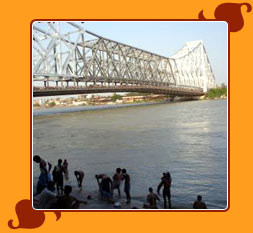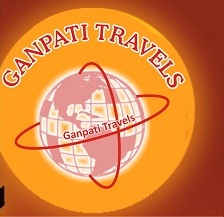Kolkata is the second largest city of India. It is
a cosmopolitan city where people, technology and ideas have blended together
with the socio-political culture to give the city a new shape. The city is
full of historical monuments and palaces and is therefore also called the “City
of Palaces”. Its glorious history dates back to 1690 when it was
selected by the British for their trade settlements.

The site was carefully chosen by the British as it was protected by the
Hooghly River on the west, a creek on the north, and by salt lakes about two
and a half miles to the east. The British defeated Siraj-ud-daullah (the
then Nawab of Bengal) on the battle field of Plassey and Calcutta became the
capital of British India. Thereafter, the city continued to play a major
role in the political affairs of India. Till 1947, the city was a venue for
major political programmes and plans for social reformation.
The
former was meant to remove British troops from the Indian soil while the
later was to create social consciousness among the people. Today, this
pulsating city with its distinct imperial flavor has become the capital of
West Bengal, a state of the Indian Union. Kolkata provides enormous
opportunities in economy, industry, education, culture, tourism and many
more aspects that other cities may not.
Holy PlacesBelur
Math:Belur Math is the most enchanting temple in Belur. In 1897
Swami Vivekananda founded Ramakrishna Mission in loving memory of his Guru
Ramakrishna Paramhansa who preached unity of all religions. It is the
international head quarters of Ramakrishna Mission. Swami Vivekananda is
largely credited with the concept of the Math.
This mission has
branches all over the country. The architecture of the structure is very
interesting. From any angle you look at it the structure is like a temple, a
mosque or a church depending on the way you look at it. The main gate of
Belur Math leads to the Ramkrishna Sarada Mandir. The mission was founded by
Swami Vivekananda (1863-1902) in 1938 and named after his mentor Shri
Ramakrishna Paramhansa (1836- 1886).
Dakshineswar Temple:The
construction of the temple started in 1847. Queen Rasmani the renowned queen
of Janbazar, had founded this temple. It is believed that she was instructed
by Goddess Kali in her dream to construct this temple. The construction work
was completed in 1855. It cost an estimated Rs. 9 lakhs of which, Rs. 2
lakhs was spent on the day of inauguration. The temple and its adjoining
areas stand on 25 acres of land. Queen Rasmani purchased the required land
from some Mr. Hasti. Dakshineswar temple is dedicated to goddess Kali. The
temple, in conventional Nava-ratna style, measures 46 feet square and rises
over 100 feet high. It is one of the largest temples of Kolkata.
Nakhoda
Mosque :In the past it was a small mosque. In 1926, a resident of
Cutch, Abdar Rahim Osman built the present mosque, the biggest in
Kolkata.It has been built in the style of Akbar's tomb at Sikandra-an example
of Indo-Saracenic architecture. The total cost incurred for the construction
was Rs. 15 lakhs. About 10,000 men can perform the 'Namaaz' in the
stupendous prayer hall of the mosque. In between is a dome and two minarets
which are 151ft. high. There are 25 tiny pillars beside these which are
100ft. - 117ft. tall. The gateway of this mosque is an ersatz of the Buland
Darwaza at Fatehpur Sikri. For this purpose granite stones were brought from
Tolepur. Inside is a superb exhibition of exquisite ornamentation and
artistic extravaganza.
Thanthania Kalibari:Opinions
differ about the date of construction of Thanthania Kalibari. Some say it
was built in 1703 whereas some regard it as 1803. On the stone structure in
the temple wall is inscribed, '1110' (Bengali calendar). Going by this, the
date of the foundation of the temple should be 1703 according to English
calendar.
GardensEden Garden:Eden
Garden is the oldest cricket ground in India and is also considered one of
the finest in the world. It was created in 1840 and named after the sister
of Lord Auckland, the former governer general. The idea was to make a
Biblical - style garden of Eden in India. The expanse dotted with beautiful
trees and shrubs is intersected by winding paths, and there is a large
artificial lake. Adjoining the lake is the Pagoda which was brought to
Kolkata from Burma after the British defeated the Burmese in the war of
1884. Near the garden you can take a pleasant walk along the bank of hooghly
river.
Botanical Garden:The gardens were originally
founded in 1786 by Colonel Kyd, containing about 12,000 living plants and
over two and half million dried out plant specimens in the herbarium
collected from all over the world. This is the oldest of all the Botanical
Gardens in India. It was from these gardens that the tea now grown in Assam
and Darjeeling was first developed. Trees of the rarest kinds, from Nepal,
Brazil, Penang, Java and Sumatra can be found here. There are towering
Mahogany trees, an avenue of Cuban Palms and an Orchid House.
MonumentsHowrah
Bridge:Popularly known as the Rabindra Setu, Howrah Bridge is an
engineering marvel and is counted amongst the busiest cantilever bridge in
the World. Observing a daily traffic of about 60,000 vehicles and
innumerable pedestrians, Howrah bridge have equalled its position to Sydney
Harbor Bridge. But the later can never dream of such a traffic. The bridge
connects Kolkata and Howrah and is the lifeline of the city. The best way to
enjoy its stately beauty is to view it from the middle of the river.
Saheed
Minar:The enchanting Saheed Minar of Kolkata is made on similar
lines of famous Qutub Minar of Delhi and forms an important landmark of
Kolkata. Popularly known as the Octerloney Monument, the minar was built in
1848 by Sir David Ochterlony to commemorate his victory in the Nepal War
(1814-1816).
Writer's Building :A massive red
building was originally built as a residence for the British East India
Company's clerical and administrative staff called as writers, hence the
name Writers' building. This building summarises the political revolution of
Bengal. The Chief Minister's office is also located in this building.






